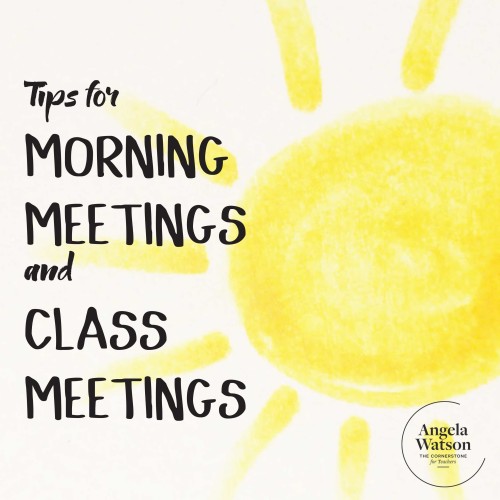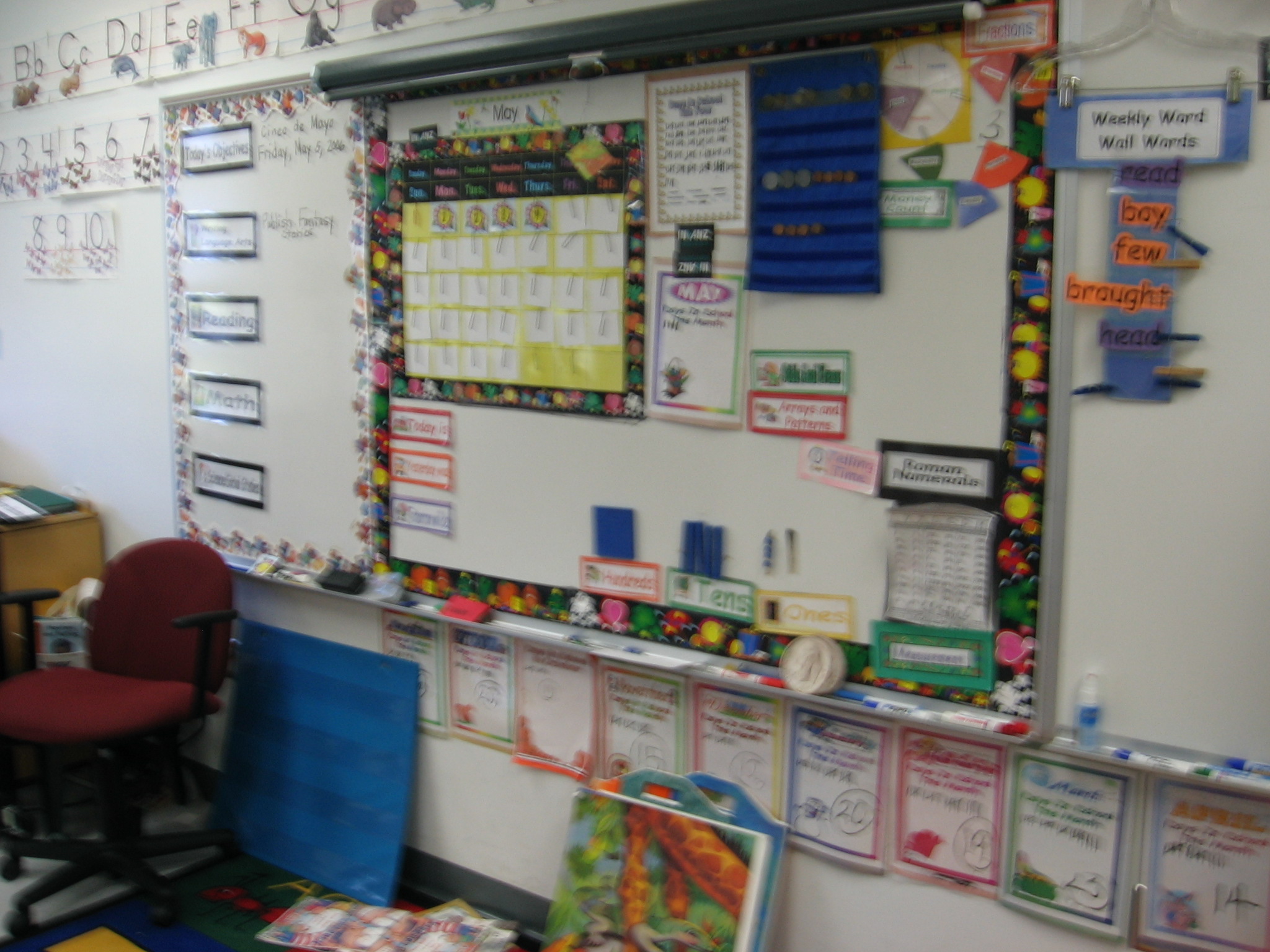Many teachers incorporate class meetings or morning meetings into their everyday classroom routines. These daily gatherings can be incredible tools for modeling and reinforcing both academic and social skills. This page will give you ideas for setting up your meeting area and provides tips for running morning meetings that set a positive tone for the day.

What to do during class meetings
Some teachers use morning meetings primarily for socio-emotional development and others focus entirely on academic skills, while other teachers address both areas to varying extents. In early childhood classrooms, class meetings are often called Circle Time, and consist of a greeting song, calendar, weather, a review of the daily schedule, class news, and sometimes a group team-building activity. Primary classrooms sometimes include a combination of these elements are more in-depth calendar math.
I’ve also held afternoon meetings, which take 2-3 minutes and involve a time of personal and/or shared reflection on what students learned and accomplished during the day. I once read that the hug at the end of the day is as important as the greeting in the morning, and I tried to always end things on a positive note with my kids.
Regardless of what time of day you choose to hold meetings or what you focus on during that time, I feel that having a regular (if not daily) routine in which students gather together on the rug or carpet to interact is a very powerful concept. It’s a great alternative to keeping kids at their desks or tables all day, and it’s often easier to keep kids focused when they’re sitting at your feet rather than across the room.
Start with a greeting
I’ve held a variety of class meetings with my students (including students in the upper elementary grades) to build community and establish the day’s agenda. To set the right tone, we would always start with a greeting activity.
In the beginning of the year when I was still establishing behavioral expectations, I liked to start with a very simple greeting. Usually I’d teach students to say ‘good morning’ in different languages and we’d practice shaking hands and saying greeting each other. I’d introduce a different language each week for about a month, and then the fifth week, let students choose which language they’d like to use.
The next greeting I typically introduced would usually prove to be one of the most popular: the One Minute Greeting. I’d set a timer for one minute and the students would try to greet each person in the class (using a verbal greeting including the person’s name,a smile, eye contact, and a handshake or hug). It was a lot of fun and really created a sense of being a family, and I loved that it took so little time!
You can see a 4th grade example of the One Minute Greeting in the video below by Responsive Classroom. The video clip does not show the entire process of explaining the greeting to students or what happens when the timer goes off, which is unfortunate. However, I like the way this teacher models the technique with three students before having the whole class practice. Take note of how she debriefs afterward–this is a good example of how to establish morning meeting routines:
Social problem-solving and review of behavioral expectations
Morning meeting is a fantastic time to hold problem-solving sessions that address class issues such as bullying, name-calling, misuse of playground equipment, hallway behavior problems, etc. I loved knowing that morning meeting was a set time in our class devoted to solving problems because I rarely had to take away instructional time during the day to address issues. I’d often incorporate read-alouds, such as the ones featured on the 5 Pro-Active Strategies page, and facilitate discussion based on the books.
I also tried to include some sort of sharing time in which students could talk about important things happening in their lives (kind of like a show and tell without the ‘show’, so as not to emphasize materialism and a sense of competition). The children would talk about what they dreamed the night before, share a poem or drawing they’d created, show a photo of something they’d done over the weekend, or talk about something funny that happened when they were very little. Afterward, they would take three comments or questions, which was a time to build both receptive and expressive oral language skills and reinforce social norms. One year, I kept this sharing time separate from the meeting and allowed students to eat their snacks during it. This was a nice mid-morning break and helped maintain the sense of collaboration that we’d started building in the morning meeting.

Incorporating academic routines
A class meeting is also a perfect opportunity to conduct routine practice exercises, such as calendar math (Everyday Math, Every Day Counts, etc.) The key to making this interesting for students day after day is a quick pace and fun activities that they look forward to. Varying the routine a bit over time is also very important.
Here’s a video of how a kindergarten teacher keeps morning meeting fast-paced and exciting. There are a number of other morning meeting videos on YouTube but this was one of the few that I felt consistently demonstrated effective teaching practices. This teacher utilizes lots of whole brain teaching techniques, which means you’ll see how she keeps all her students actively involved. This clip is actually part two: she review class rules, then moves into calendar math, weather, and other academic concepts. You can view part one of the clip here, in which she demonstrates how students move from their desks to the rug in an orderly way and begin the meeting. Her teaching style is more high-energy and regimented than mine, but I just love how all the students are so on-task and engaged–very impressive!
Decorating and arranging your class meeting area
After you’ve determined the purpose of your class meetings, you can create an area that supports your goals. Be sure to design the space so that your materials are close at hand and students can easily see the props and materials you’ll be using. I prefer to have assigned seats for students (written on tape for early childhood classrooms) to make sure that students aren’t seated near people that will get them off-task. By the middle of the school year, I let kids choose their spots (and change them whenever there is a problem), although I did reserve the right to overrule if I thought the choice wasn’t working out.
Here are some photos of how real teachers have set up their meeting areas (click to enlarge).











Angela Watson
Founder and Writer
Sign up to get new Truth for Teachers articles in your inbox
Discussion
OR

Join our
community
of educators
If you are a teacher who is interested in contributing to the Truth for Teachers website, please click here for more information.
















Thanks you!! It is very effective and it helps me how to incorporate morning meeting in our academic work and group work activity.
I would really like to see a video of a Teacher,( if you know where I can go to watch). going thru the Morning meeting transitioning to calendar Math etc. Its unfortunate the Kinder teacher you mentioned in your post’s video is not available> thanks .